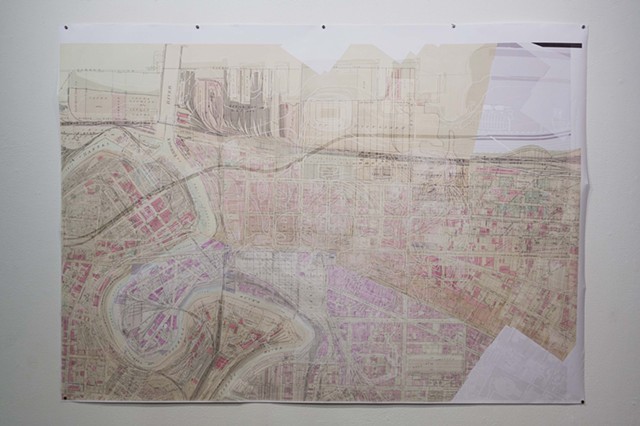Sculpture & Installations
Growing up in upstate New York, the Adirondack Mountains were always in my periphery; acting as a constant, a guide and landmark. Now residing in flat and topographically mundane Northeastern Ohio, it is the architectural skyline that plays this role. What if this city was a mountain? fuses the technical and realistic aspects of the terrain modeling of late 19th century Swiss and Austrian relief artists (Xaver Imfeld, Paul Oberlercher) while encouraging viewers to reflect on their relationship with the actual city..
I'm interested in juxtaposing the miniature sublime and the viewer, who, by scale, would be the omni-element confronting a new domain. Informed by large-scale architecture, and made from synthetic material, the terrain model embodies in itself a presentation of pseudo reality made by industry to evoke the sublime on a small scale.
Execution of this project hinged on research of the architectural landscape of Downtown Cleveland. Referencing both historical and contemporary mapping tools, I was able to plot the location and varying height of Cleveland’s topography. From the West Side Market to Cleveland State University, from Progressive Field to the peak of Key Tower, two-dimensional architectural cartography guided the sculptural construction. Thus began a re-imagining of our city; our city as a mountain.
The mountain itself was constructed in two phases. Initially a single mountain was erected in plaster, foam and paper; followed by the casting process and assistance from expert and artist friend Lillian Harden. The imposing product informed the process; and as a result was broken into 16 separate geographic cross sections. I am not a sculptor. Working primarily as a painter the construction of What if this City Was a Mountain? tore me from my comfort zone. However, the consistent evaluation and re-imagining of material throughout construction heavily echoes the methodology of my painting process.
Additionally displayed in the gallery, in conjunction with What If This City Was a Mountain?, are curated artifacts and remnants of my process throughout each phase of research, design and construction. Resource maps, layers of silicone remnants and a mother mold surround the work and provide insight into the heritage of the piece. On display within the gallery is a synthesis; a question answered. What if this city was a mountain?
SPECIAL THANKS
A special thanks to Lillian Harden, whose patience and knowledge of casting helped realize my idea. And too the staff at the Cleveland Public library, especially Thomas Edwards in the Map Room who assisted in resources and printing of my reference material. Thanks to SPACES staff, especially Bruce Edwards who too provided material suggestions and avenues of exploration. A big thank you to my wife Laura who never fails to help hone my ideas. And finally to Matthew Fitzpatrick and Paul Sobota who were the crucial third (and fourth) hands in handling fast expanding foam.
